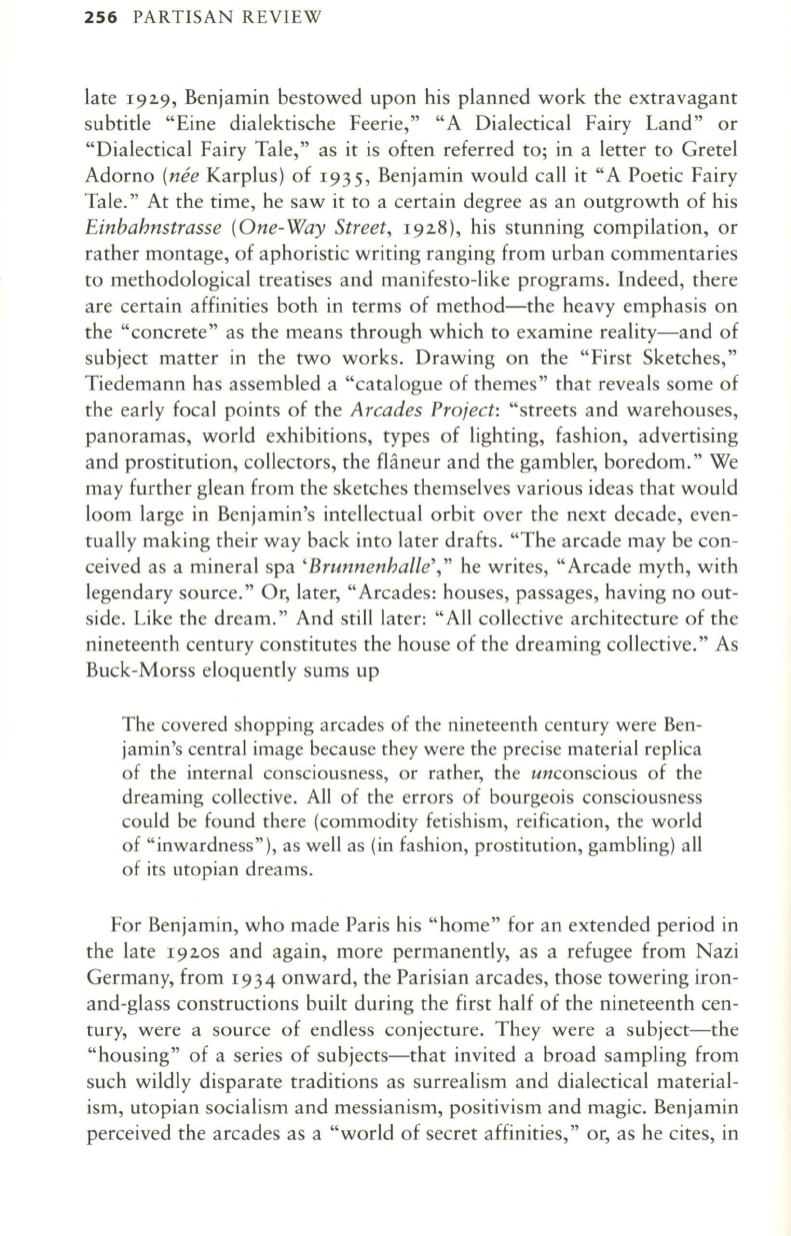
256
PARTISAN REVIEW
late
1929,
Benjamin bestowed upon his planned work the extravagant
subtitle "Eine dialektische Feerie," "A Dialectical Fairy Land" or
"Dialectical Fairy Tale," as it is often referred to; in a letter to Gretel
Adorno
(nee
Karplus) of
1935,
Benjamin would call it "A Poetic Fairy
Tale." At the time, he saw it to a certain degree as an outgrowth of his
Einbahnstrasse (One-Way Street,
1928),
his stunning compilation, or
rather montage, of aphoristic writing ranging from urban commentaries
to methodological treatises and manifesto-like programs. Indeed, there
are certain affinities both in terms of method-the heavy emphasis on
the "concrete" as the means through which to examine reality-and of
subject matter in the two works. Drawing on the "First Sketches,"
Tiedemann has assembled a "catalogue of themes" that reveals some of
the early focal points of the
Arcades Project:
"streets and warehouses,
panoramas, world exhibitions, types of lighting, fashion, advertising
and prostitution, collectors, the flaneur and the gambler, boredom." We
may further glean from the sketches themselves various ideas that would
loom large in Benjamin's intellectual orbit over the next decade, even–
tually making their way back into later drafts. "The arcade may be con–
ceived as a mineral spa
'Brunnenhalle',"
he writes, "Arcade myth, with
legendary source." Or, later, "Arcades: houses, passages, having no out–
side. Like the dream." And still later: "All collective architecture of the
nineteenth century constitutes the house of the dreaming collective." As
Buck-Morss eloquently sums up
The covered shopping arcades of the nineteenth century were Ben–
jamin's central image because they were the precise material replica
of the internal consciousness, or rather, the
unconscious
of the
dreaming collective. All of the errors of bourgeois consciousness
could be found there (commodity fetishism, reification, the world
of "inwardness"), as well as (in fashion, prostitution, gambling) all
of its utopian dreams.
For Benjamin, who made Paris his "home" for an extended period in
the late
1920S
and again, more permanently, as a refugee from Nazi
Germany, from
1934
onward, the Parisian arcades, those towering iron–
and-glass constructions built during the first half of the nineteenth cen–
tury, were a source of endless conjecture. They were a subject-the
"housing" of a series of subjects-that invited a broad sampling from
such wildly disparate traditions as surrealism and dialectical material–
ism, utopian socialism and messianism, positivism and magic. Benjamin
perceived the arcades as a "world of secret affinities," or, as he cites, in


